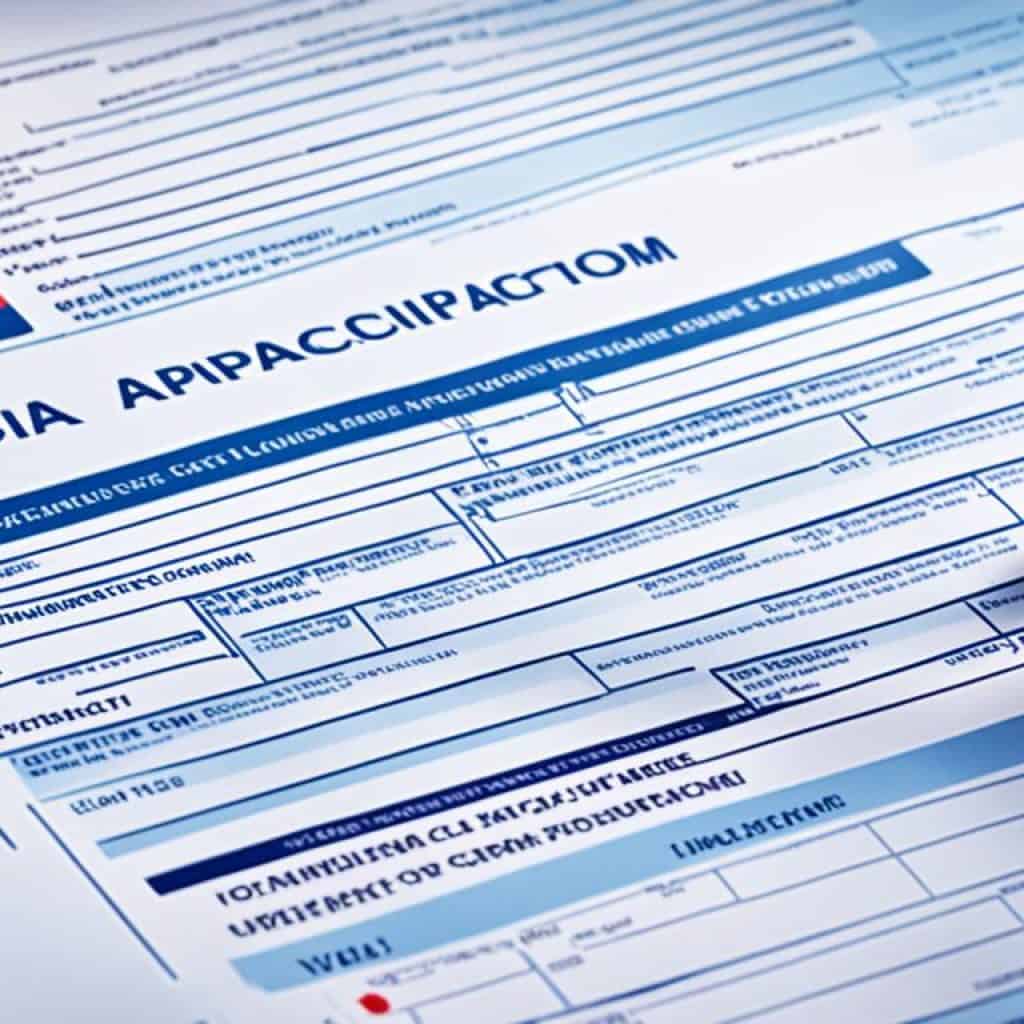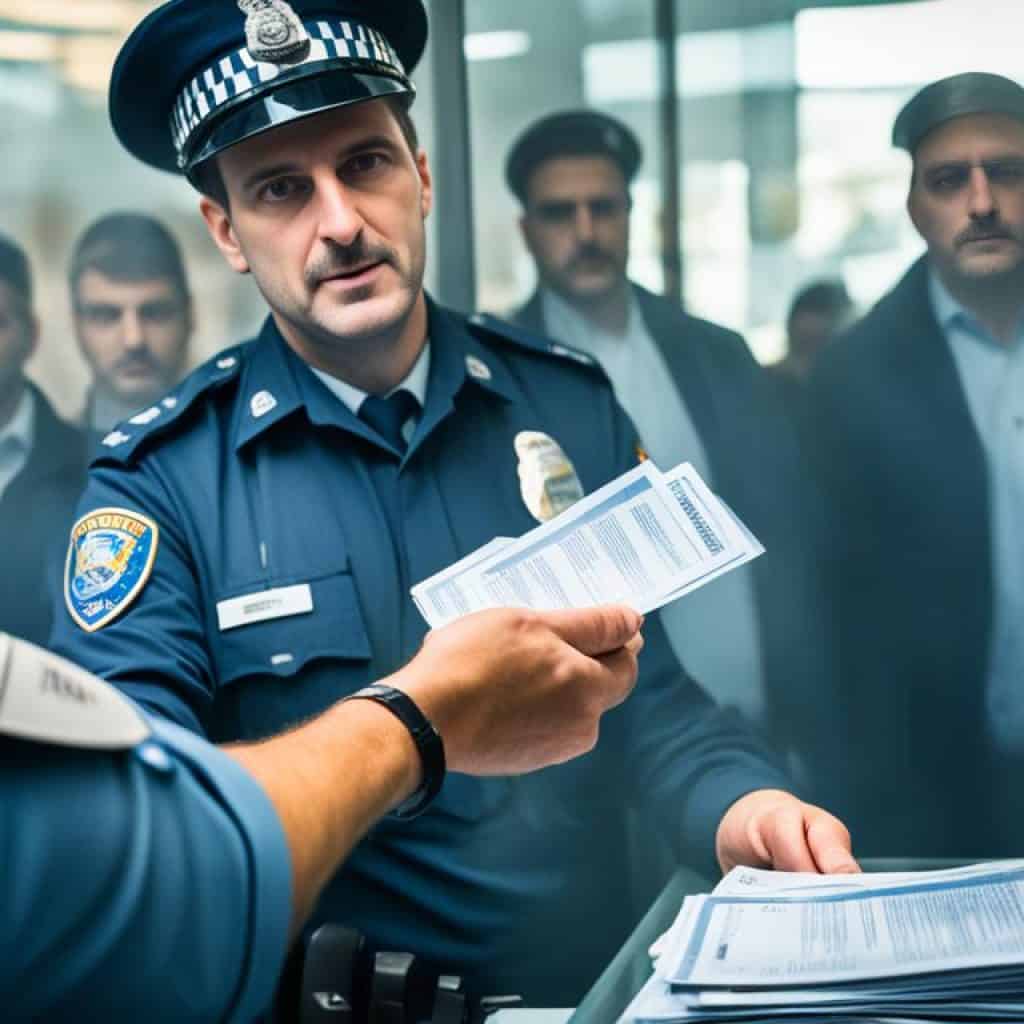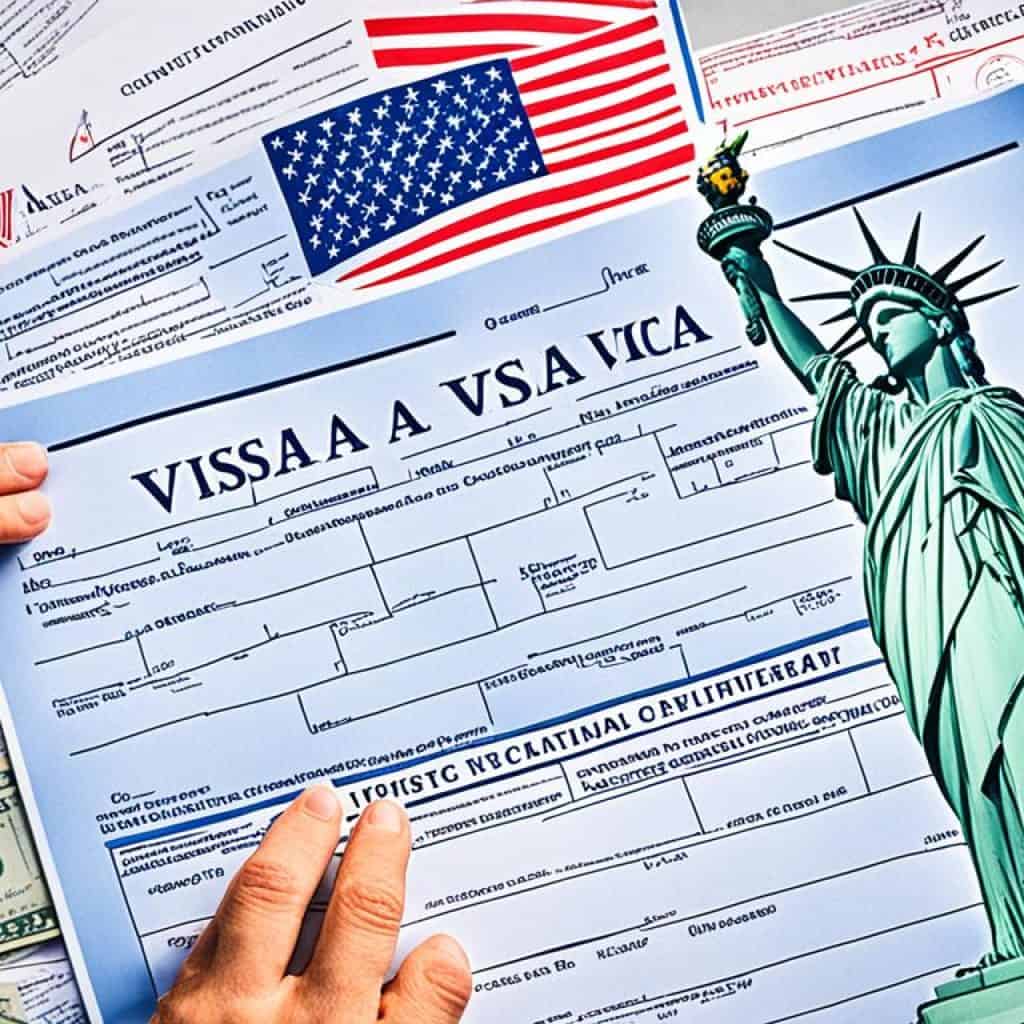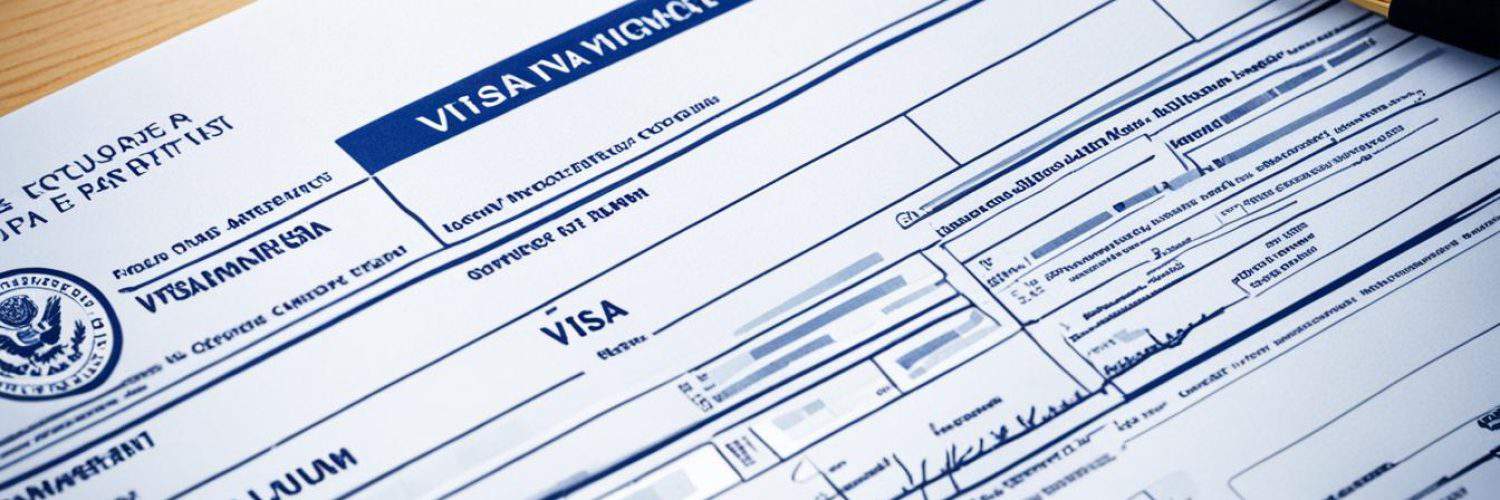Are you ready to embark on your journey to the United States? Whether you’re planning a vacation or pursuing educational or business opportunities, applying for a US visa is a crucial step. But have you ever wondered what it takes to complete the visa application process? Is it as complicated as it seems, or is there a quick and easy way to navigate through the forms?
In this comprehensive guide, we will break down the process of US visa applications forms, providing you with everything you need to know to make the process smooth and hassle-free. From checking the validity of your passport to completing the visa application form, gathering supporting documents, and scheduling an interview appointment, we’ve got you covered.
So, are you ready to unlock the secrets of the US visa application process? Let’s dive in!
Key Takeaways:
- Applying for a US visa involves several important steps, including checking the validity of your passport, completing the visa application form accurately, gathering the necessary supporting documents, scheduling an interview appointment, paying the visa fee, and returning to collect your passport and visa.
- It is crucial to follow the instructions carefully and provide accurate and complete information on the visa application form.
- While visitors to the United States are not obligated to purchase health insurance, it is highly recommended due to the high costs of healthcare in the US.
- The process of applying for a US visa may vary depending on your country of residence, so it is important to consult the respective embassy or consulate for specific instructions and requirements.
- As a permanent resident of the United States, it is important to understand your rights and responsibilities to maintain your status.
Step 1: Check the Validity of your Passport
Before applying for a US visa, it is crucial to ensure that your passport is valid for at least six months beyond your intended stay in the United States. This requirement is necessary to comply with country-specific agreements. If your passport is not valid for the required period, you will need to obtain a new passport before proceeding with the visa application process.
In Section 2, we emphasize the importance of checking your passport validity before starting the US visa application process. Your passport must be valid for at least six months beyond your intended stay in the United States. This requirement is essential to comply with country-specific agreements and ensure a smooth visa application process. If your passport does not meet this requirement, you will need to apply for a new passport before proceeding further.
Having a valid passport is crucial because it establishes your identity and nationality. It is the primary document required for international travel and is equally vital for US visa applications. The US government enforces the six-month passport validity rule to ensure that travelers have sufficient validity remaining on their passport throughout their stay in the United States.
Being aware of your passport’s expiration date and proactively renewing it, if necessary, can save you time and prevent any delays in the visa application process. It is recommended to check your passport’s validity well in advance, as passport renewal can take several weeks or even months, depending on your country of residence.
If your passport is nearing expiration or has already expired, you should contact your country’s passport issuing authority or visit their website to initiate the passport renewal process. Renewing your passport early also allows you to update any personal information that may have changed since your last passport was issued.
Remember, having a valid passport is the first step towards successfully applying for a US visa. Make sure to complete this important requirement before moving on to the next steps in the visa application process.
Step 2: Complete the Visa Application
To apply for a US visa, you must complete the Online Non-immigrant Visa Application form, also known as Form DS-160. This comprehensive form collects essential information about your background, purpose of visit, and eligibility for a US visa. It is crucial to answer every question on the application form accurately and honestly, ensuring that all information provided is complete and up to date.
When filling out the DS-160 form, take the time to carefully review each question and provide detailed responses. If a specific question does not apply to you, indicate “none” or “not applicable” instead of leaving it blank. Incomplete or incorrect forms may be returned, causing delays in the visa application process and requiring you to schedule a new interview appointment.
It is important to note that filling out the DS-160 form is free, and you do not need the assistance of a third-party service to complete it. Be cautious of any company or individual offering to expedite your visa appointment or processing, as they cannot guarantee the outcome and may charge unnecessary fees.
Some key points to remember:
- Complete the Online Non-immigrant Visa Application form (Form DS-160) accurately and honestly.
- Answer every question on the application form, indicating “none” or “not applicable” when necessary.
- Avoid leaving any sections of the form blank, as it may lead to delays or requests for additional information.
- Filling out the DS-160 form is free, and you do not need the services of a third-party to complete it.
- Be cautious of any company or individual offering to expedite your visa appointment or processing, as they cannot guarantee the outcome.
By completing the visa application form accurately and providing all the necessary information, you increase your chances of a successful visa application process. Remember, attention to detail is key.

Once you have completed the visa application form, you will be one step closer to your journey to the United States. The next section will guide you on collecting any supporting documentation required for your visa application.
Step 3: Collect any Supporting Documentation
While the only required documents for a nonimmigrant visa interview are your passport, DS-160 confirmation page, and a recent photo, additional documents may be requested to establish your qualifications. These documents may include evidence of the purpose of your trip, your intent to depart the United States after your visit, and your ability to cover the expenses of your trip. It is important to note that a letter of invitation or Affidavit of Support is not necessary for a nonimmigrant tourist visa application. However, if you choose to bring a letter of invitation or Affidavit of Support to your interview, it is not a determining factor in the visa issuance process.
“Additional documents may be requested to establish your qualifications.”
During your visa interview, the consular officer may request specific documents to verify the purpose of your visit and ensure that you meet the eligibility criteria for the visa category you are applying for. This could include:
It is essential to prepare and bring all requested documents to your visa interview to avoid delays or potential denials. Be sure to review the specific requirements for your visa category and consult the official website of the embassy or consulate in your country for detailed instructions.
Benefits of Preparing Supporting Documentation
Providing comprehensive and well-organized supporting documentation can enhance your visa application and increase your chances of a successful outcome. By submitting the necessary documents, you demonstrate your intent to comply with the visa requirements and your willingness to provide any information deemed necessary by the consular officer. Adequate supporting documentation also helps address any potential concerns regarding your eligibility or purpose of travel, providing the consular officer with a complete picture of your situation.
When preparing your supporting documents, be sure to:
- Include originals or clear copies of all required documents
- Translate any documents not in English into English
- Keep your documents organized and easily accessible
- Provide clear and concise explanations for any inconsistencies or unusual circumstances
By following these guidelines, you can present a strong case to the consular officer and increase your chances of a favorable visa decision.
Step 4: Schedule an Interview Appointment, if required
Once you have completed the necessary steps in the US visa application process, such as checking the validity of your passport, completing the visa application, and gathering supporting documents, the next step is to schedule an interview appointment, if required.
Depending on the visa category and your country of residence, an interview appointment at the embassy or consulate may be necessary. Scheduling an interview appointment is an important part of the visa application process and ensures that a consular officer can assess your eligibility for a visa and the appropriate visa category.
To schedule an interview appointment, you can consult the NIV Appointment System, which is an online platform provided by the US Department of State. Make sure to have your DS-160 confirmation number ready, as it may be required during the appointment scheduling process.
It is important to note that some visa categories may qualify for an interview waiver or visa application renewal by mail. If you meet the criteria for these exemptions, you may not need to schedule an interview appointment. However, it is crucial to carefully follow the specific instructions provided by the embassy or consulate in your country of residence.
Visa interview appointments are typically conducted in person, allowing the consular officer to ask you questions and verify your eligibility for a US visa. It is important to be well-prepared and have all the necessary documents with you during the interview. Remember to dress appropriately and be respectful throughout the appointment process.
Once you have successfully scheduled your interview appointment, make sure to arrive at the embassy or consulate on time. Late arrivals may result in rescheduling the appointment, which can cause delays in the visa application process.
“The visa interview appointment is a critical step in the US visa application process, as it allows the consular officer to assess your eligibility and the appropriate visa category. Prepare well, be honest, and provide all necessary documents to increase your chances of a successful outcome.”
– John Anderson, Immigration Attorney
Once the interview is complete, the consular officer will inform you of the next steps. If your visa is approved, you will need to pay the visa fee and return to the embassy to collect your passport and visa. It is important to comply with any additional instructions provided by the embassy or consulate before your departure.
Step 5: Visa Fee Payment and Interview
Once you have completed the necessary steps in your US visa application process, it’s time to proceed with the visa fee payment and interview. These final stages are crucial to finalize your application and determine your eligibility for a US visa.
To begin, it is essential to bring the required visa fee amount in cash or a credit card. However, please note that the embassy does not accept credit card payments, so it’s recommended to have cash on hand. The visa fee varies depending on the visa class you are applying for, so make sure to check the travel.state.gov website for the most up-to-date visa fee information.
If you are applying for certain visa types, such as L-1 and H-1B, additional fees may apply. Furthermore, citizens of certain countries may be subject to a reciprocity fee if their visa application is approved. Therefore, it is crucial to be aware of any potential additional fees that may be relevant to your specific circumstances.
Once you have paid the required visa fee, you will proceed with the interview appointment at the embassy or consulate. The visa interview is a crucial part of the application process, as it allows a consular officer to assess your eligibility for a US visa and determine the appropriate visa category for your needs.
“The visa fee payment and interview are the final steps in your US visa application process. It’s important to be prepared and bring the necessary payment in cash or credit card, as well as any supporting documents requested by the embassy. Remember, your interview is an opportunity to demonstrate your qualifications and intentions to the consular officer, so approach it confidently.”
During the interview, the consular officer may ask you questions about your travel plans, the purpose of your trip, and your ties to your home country. It is important to provide honest and accurate answers, and if you have any supporting documentation, such as a letter of invitation or proof of employment, have them readily available.
After the interview, the consular officer will make a decision regarding your visa application. If your application is approved, you will proceed with the final steps to collect your passport and visa. However, if your application is denied, the consular officer will provide you with an explanation for the decision.
These final stages of the US visa application process are crucial to realizing your travel plans. By carefully preparing for the visa fee payment and interview, you can increase your chances of success and ensure a smooth application process.
Visa Fee Payment and Interview Guidelines
| Step | Guidelines |
|---|---|
| 1 | Bring the required visa fee amount in cash or a credit card. |
| 2 | Check the travel.state.gov website for the most up-to-date visa fee information. |
| 3 | Be aware of additional fees that may apply to certain visa types or specific countries. |
| 4 | Prepare for the visa interview by reviewing your travel plans and supporting documentation. |
| 5 | Approach the interview confidently and provide honest and accurate answers. |
| 6 | After the interview, follow the instructions provided by the embassy for collecting your passport and visa. |
Step 6: Return to Collect your Passport and Visa
If your visa application is approved, the final step is to return to the embassy or consulate to collect your passport and visa. Typically, you can pick up your documents the following workday.
The embassy or consulate will notify you by email or phone when your visa is ready for pick-up. It’s important to pay attention to these notifications to ensure a smooth collection process.
In some cases, if you are unable to collect your visa and passport in person, you may authorize a third-party to do so on your behalf. To grant authorization, you will need to provide a signed letter to the embassy or consulate.
Please note: It is crucial not to make any travel arrangements until you have your passport and visa in your possession. Failure to do so may result in financial losses or complications with your travel plans.
Visa Collection Checklist
Before heading to the embassy or consulate to collect your passport and visa, make sure you have the following items:
- ID proof (such as a driver’s license or national identification card)
- Appointment confirmation
- Receipt of visa fee payment
- Authorization letter (if applicable)
Once you arrive at the embassy or consulate, follow the instructions provided and proceed to the designated collection area. Staff members will guide you through the process and ensure that all necessary documents are handed over to you securely.
| Documents to Collect | Additional Information |
|---|---|
| Passport | Your valid passport will be returned to you with the visa stamped inside. |
| Visa | Your approved US visa will be affixed to your passport. |
Congratulations! You have successfully completed the US visa application process. Now, you can make your travel arrangements and look forward to your visit to the United States.

Do Visitors to the United States Have to Purchase Health Insurance?
While visitors to the United States are not obligated to purchase health insurance, it is highly recommended to have health insurance coverage before embarking on your trip. The healthcare costs in the US can be significantly higher compared to other countries, and having insurance can provide vital financial protection in case of any unexpected medical emergencies.
Having health insurance for visitors to the US offers several benefits. It can help cover the costs of doctor visits, hospital stays, prescription medications, and emergency medical care. In case of any unforeseen accidents, illnesses, or injuries, insurance can alleviate the burden of expensive medical bills and ensure that you receive the necessary care without incurring significant out-of-pocket expenses.
Moreover, it is important to note that medical emergencies can happen unexpectedly, and without insurance, the cost of healthcare in the US can be a significant financial burden. By obtaining health insurance coverage prior to your trip, you can protect yourself and your finances from any unforeseen medical circumstances.
When considering health insurance options for your visit to the US, it is essential to carefully review the coverage and benefits offered by different insurance providers. Ensure that the insurance policy includes coverage for emergencies, hospitalizations, doctor visits, medical evacuations, and prescription medications.
It is also important to note that the US government does not provide free healthcare services to visitors, and medical expenses can quickly escalate, especially in emergency situations or prolonged hospital stays. It is, therefore, advisable to plan for the unexpected by securing comprehensive health insurance coverage before traveling to the US.
Benefits of Health Insurance for Visitors to the US:
- Financial protection against high medical costs
- Access to quality healthcare services
- Peace of mind during your trip
- Coverage for emergencies, hospitalizations, and doctor visits
- Protection against unforeseen medical expenses
By prioritizing your health and well-being through adequate insurance coverage, you can fully enjoy your visit to the United States without unnecessary worries about medical costs.
| Health Insurance Providers | Features |
|---|---|
| Provider A | Comprehensive coverage for medical emergencies and hospitalizations. Includes access to a network of healthcare providers nationwide. |
| Provider B | Affordable insurance plans with competitive premiums, covering a wide range of medical services and treatments. |
| Provider C | Specialized insurance packages designed for visitors to the US, offering tailored coverage and flexible payment options. |
Applying for a US Visa From Different Countries
The process of applying for a US visa may vary depending on your country of residence. While citizens of the United Kingdom can travel to the US without a visa, they still need to follow specific procedures for visa applications. On the other hand, residents of other countries such as Canada, Australia, UAE, Qatar, Philippines, and India may need to apply for a US visa.
When applying for a US visa, it is essential to consult the respective embassy or consulate’s website for detailed instructions and requirements specific to your country. Each country has its own procedures and documentation requirements, so it’s important to follow the guidelines provided to ensure a smooth application process.
Here are a few examples of the visa application processes for citizens of different countries:
- Applying for a US Visa from the UK: UK citizens can travel to the US without a visa but are required to complete the Electronic System for Travel Authorization (ESTA) before their trip.
- Applying for a US Visa from Canada: Canadian citizens generally do not need a visa to travel to the US for tourism or business purposes. However, certain visa categories may require a visa application.
- Applying for a US Visa from Australia: Australian citizens are eligible for the Visa Waiver Program, which allows them to travel to the US for up to 90 days without a visa. However, if their travel exceeds 90 days or they are not eligible for the Visa Waiver Program, they will need to apply for a US visa.
- Applying for a US Visa from the UAE: Citizens of the United Arab Emirates are required to apply for a US visa before traveling to the US. They need to follow the procedures outlined by the US embassy or consulate in the UAE.
- Applying for a US Visa from Qatar: Qatari citizens are generally required to apply for a US visa before their trip. They should consult the website of the US embassy or consulate in Qatar for the specific application process and requirements.
- Applying for a US Visa from the Philippines: Filipino citizens are required to apply for a US visa before their trip. They need to complete the DS-160 form and follow the procedures provided by the US embassy or consulate in the Philippines.
- Applying for a US Visa from India: Indian citizens are required to apply for a US visa before traveling to the US. They need to complete the DS-160 form and follow the procedures outlined by the US embassy or consulate in India.
By following the instructions provided by the respective embassy or consulate, residents of different countries can ensure a smooth and successful US visa application process.
Did you find this page helpful?
We value your feedback! If you found this guide helpful, please let us know. Your feedback will help us improve our services and provide more comprehensive assistance to future visa applicants.
Your Rights and Responsibilities as a Permanent Resident
As a permanent resident of the United States, you have certain rights and responsibilities. It is important to understand these rights, including the ability to live and work in the US, as well as the responsibility to maintain your permanent resident status. This section will provide an overview of your rights and responsibilities and guide you on how to comply with the requirements.
Your Rights as a Permanent Resident
Once you obtain permanent resident status, also known as a Green Card, you have the right to:
- Live and work permanently in the United States
- Be protected by all laws of the United States, at the federal, state, and local levels
- Access most benefits available to US citizens, such as educational opportunities, healthcare, and social services
- Apply for US citizenship after meeting the eligibility requirements
- Travel in and out of the United States with the proper documentation, using your Green Card as proof of your permanent resident status
Your Responsibilities as a Permanent Resident
As a permanent resident, it is important to fulfill certain responsibilities to maintain your status and contribute to the United States:
- Obey all federal, state, and local laws
- File your federal income tax returns and report your income to the Internal Revenue Service (IRS)
- Maintain your permanent resident status by renewing your Green Card before it expires
- Notify the US Citizenship and Immigration Services (USCIS) of any changes in your address within 10 days of relocation
- Support the democratic values of the United States and respect the rights and freedoms of others
“With great power comes great responsibility.”
– Franklin D. Roosevelt
Remember that these are just some of the main rights and responsibilities of permanent residents. It is essential to stay informed about any changes in immigration laws and regulations that may affect your status. By understanding and fulfilling your rights and responsibilities, you can enjoy the benefits of permanent residency and actively contribute to your new home in the United States.
If you have any questions or need further guidance, it is recommended to consult the official resources provided by the US Citizenship and Immigration Services (USCIS).
Rights and Responsibilities Comparison
| Permanent Resident Rights | Permanent Resident Responsibilities |
|---|---|
| Live and work permanently in the United States | Obey all federal, state, and local laws |
| Be protected by all laws of the United States, at the federal, state, and local levels | File federal income tax returns and report income to the IRS |
| Access most benefits available to US citizens | Maintain permanent resident status by renewing your Green Card |
| Apply for US citizenship after meeting eligibility requirements | Notify USCIS of any changes in your address |
| Travel in and out of the United States | Support the democratic values of the United States and respect the rights and freedoms of others |
Remember, being a permanent resident of the United States grants you many benefits, but it also comes with responsibilities. By upholding your responsibilities, you can enjoy the full rights and privileges of your permanent resident status while contributing to the vibrant and diverse fabric of American society.
Getting Settled in the United States
Once you have obtained your US visa and arrived in the United States, there are several important steps to take to get settled. This section will guide you through the process of getting a Social Security Number, finding a place to live, looking for a job, arranging for child care, and navigating transportation options in the US.
1. Getting a Social Security Number
One of the first things you’ll need to do when you arrive in the US is to apply for a Social Security Number (SSN). The SSN is a unique nine-digit identification number issued by the Social Security Administration (SSA). It is essential for various purposes, such as employment, opening a bank account, and filing taxes. To apply for an SSN, you will need to complete an application form (Form SS-5) and provide the required documentation, including your visa, passport, and proof of employment eligibility. The SSA will issue your SSN within a few weeks after processing your application.
2. Finding a Place to Live
Looking for a place to live is an important aspect of settling in the US. Depending on your preferences and budget, you can choose to rent an apartment, house, or condominium. The process typically involves searching for available listings either online or through real estate agents, visiting the properties, and signing a lease agreement. Consider factors such as location, proximity to amenities, safety, and transportation access when making your decision. It is also advisable to review and understand the terms and conditions of the lease agreement before signing.
3. Looking for a Job
If you plan to work in the US, you will need to search for suitable job opportunities. Start by updating your resume and creating a professional online presence on platforms such as LinkedIn. Explore job search websites, company career pages, and industry-specific platforms to find job openings that match your skills and experience. Networking is also crucial in the US job market, so reach out to connections, attend job fairs, and consider joining professional organizations. Tailor your application materials for each job, and prepare for interviews by researching the company and practicing common interview questions.
4. Arranging for Child Care
If you have children, finding appropriate child care arrangements is vital to ensure their well-being while you work or settle into your new life in the US. There are various options available, including daycare centers, home-based care, and hiring a nanny. Research local regulations and standards for child care providers, visit potential facilities, and inquire about their programs, staff qualifications, and safety measures. Consider factors such as location, hours of operation, cost, and the quality of care provided when making your decision.
5. Navigating Transportation Options
Understanding transportation options is essential for getting around and exploring your new surroundings in the US. Depending on the location, you may have access to public transportation systems such as buses, trains, or subways. Research local transportation authorities and familiarize yourself with routes, schedules, and fares. If you plan to drive, you will need to obtain a US driver’s license by passing the required tests. Alternatively, you can use ride-sharing services such as Uber or Lyft or consider purchasing a vehicle if necessary. It is also worth exploring biking or walking options in areas where they are accessible and safe.
Getting settled in the United States involves several key steps, from obtaining a Social Security Number and finding a place to live to looking for a job, arranging for child care, and understanding transportation options. By taking these necessary steps, you can start your new life in the US with ease and confidence.
| Step | Action |
|---|---|
| 1 | Apply for a Social Security Number (SSN) |
| 2 | Search for available listings and sign a lease agreement for a place to live |
| 3 | Update your resume, search for job opportunities, and prepare for interviews |
| 4 | Research child care options, visit potential facilities, and make a decision |
| 5 | Familiarize yourself with transportation options and obtain a driver’s license if necessary |

Conclusion
Applying for a US visa can be a straightforward process if you follow the necessary steps. By checking the validity of your passport, completing the visa application accurately, gathering the required supporting documentation, scheduling an interview appointment, paying the visa fee, and returning to collect your passport and visa, you can navigate the application process successfully.
It is important to remember that as a permanent resident, you have rights and responsibilities. Complying with these responsibilities will help you maintain your permanent resident status and enjoy the benefits of living and working in the United States.
Once you have obtained your US visa and arrived in the country, take advantage of the resources available to help you settle in. Whether it’s obtaining a Social Security Number, finding a place to live, looking for a job, arranging for child care, or navigating transportation options, there are many resources and services that can assist you.
By following the US visa application process and taking advantage of the resources available, you can successfully apply for a US visa and start your journey to live, work, or study in the United States. Good luck!
FAQ
What is the first step in applying for a US visa?
The first step is to check the validity of your passport, ensuring it is valid for at least six months beyond your intended stay in the United States.
What form do I need to complete for the US visa application?
You need to complete the Online Non-immigrant Visa Application form, also known as Form DS-160.
Are there any supporting documents required for the US visa application?
While the only required documents are your passport, DS-160 confirmation page, and a recent photo, additional documents may be requested to establish your qualifications.
Do I need to schedule an interview appointment for the US visa?
Depending on the visa category and your country of residence, you may be required to schedule an interview appointment at the embassy or consulate.
How much is the visa fee?
The visa fee varies depending on the visa class you are applying for. It is advisable to check the travel.state.gov website for the most up-to-date visa fees.
How do I collect my passport and visa after approval?
If your visa is approved, you can typically return to the embassy the following workday to collect your passport and visa.
Is health insurance required for visitors to the United States?
Visitors are not obligated to purchase health insurance, but it is strongly recommended due to the high costs of healthcare in the US.
How does the US visa application process vary for different countries?
The process may vary depending on your country of residence. It is essential to consult the respective embassy or consulate’s website for detailed instructions specific to your country.
Can I provide feedback on this guide?
Yes, we value your feedback! If you found this guide helpful, please let us know.
What are the rights and responsibilities of a permanent resident in the US?
As a permanent resident, you have certain rights and responsibilities that include the ability to live and work in the US, as well as maintaining your permanent resident status.
What steps should I take to get settled in the United States?
Once you have obtained your US visa and arrived in the United States, there are several important steps to take such as getting a Social Security Number, finding a place to live, looking for a job, arranging for child care, and navigating transportation options.








Add comment